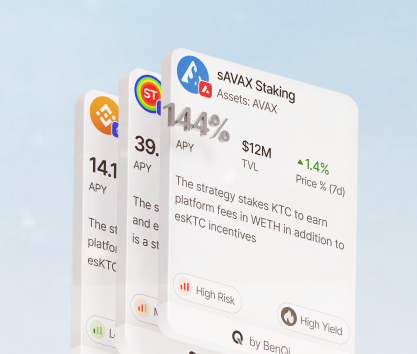“It’s not the size that matters, it’s the skill” — would say someone who is afraid of risks and does not want to go “to the moon”. Chasing the biggest yield is not inherently bad, despite the unending nagging from the critics. You should be seeking the best investment option that brings in the most profits while not exposing you to outlandish risks.
In some cases, investors with relatively small capital are justified in their desire to chase the biggest payout and use highly concentrated market positions. The issue seems to be ethical and practical as the desire to change your financial situation drastically is relatable to many common folks. However, some studies indicate that concentrated, high-risk portfolios may outperform diversified ones with too many risk management techniques hindering potential profitability.
Just like in any other life situation, the investment game is about finding the right balance and achieving consistency while trying to figure out the best way to accumulate the most resources in the shortest amount of time. For some, it is an exciting game thanks to the economic uncertainty, advanced strategizing, and the competition against others.
If you are looking for a way to build a massive portfolio quickly, checking out various staking and lending platforms that have high APYs is a good idea. Many DeFi protocols expose you to a variety of risks that must be accounted for, but they also have some of the highest interest rates in the financial world. Digital assets are still gaining traction with the global crypto market capitalization reaching $2.19 trillion in August 2024 according to CoinMarketCap.
It is expected that this number will continue to grow indefinitely until it hits its reasonable capacity. With new DeFi protocols appearing each year and the DeFi ecosystem experiencing a new wave of interoperability improvements, it is easy to see why many experts forecast the future expansion of the industry.
What is high-yield farming?
There is no official definition of what exactly constitutes a high yield. For example, many crypto enthusiasts believe that interest rates for staking on Ethereum (between 4% and 7%) are already quite high compared to savings accounts with less than 0.05% APR with annual compounding or HY bank deposits that usually yield around 5%. US treasury bonds have an interest rate of 4.11% in 2024. When compared to ETH returns, they do seem kind of small.
Simultaneously, some investors may think that 7% is not enough. They think that the true high-yield pool is something like USDC on Kamino Lend with a 12% base APY. Several protocols are offering similar interest rates to their users. In many cases, DEXes are motivated to increase potential payouts to the level where they become barely sustainable, all to keep liquidity high.
There is also a third category of investors who think that even double-digit APYs are nothing. These people chase questionable projects that have massive rewards in native tokens. SOL-USDC pool on ORCA has a 63% base APY and a 30-day average of 131%. USDC-AERO pair on Aerodrome has a 68.8% reward APY paid in AERO. These are incredibly risky investments in projects that may not even have strong enough legs to sustain themselves in the near future.
The last type of investors who jump on every hype train is closer to gambling addicts. Some projects have unreasonable APYs that can never be sustained. Others are simply memecoins or inflated native tokens that lose value continuously and do not present a viable long-term investment opportunity. For instance, the WEEBS-SOL pair on Orca has an 8,793% APY which is completely outlandish yet the total value locked number keeps climbing. It reached $8.8 million in August 2024.
Yield farming strategies
There are different approaches to building a portfolio that has a high potential return on investments using only DeFi instruments. Since there are many routes a single coin can take, we won’t be covering all existing strategies or even a tiny fraction of them. Instead, we will focus on approaches that work well and can be used by beginners.
Engage in liquid staking
This particular approach is one of the most profitable yet it has some of the biggest risks too. Below are two illustrative examples of this strategy:
- LIDO. This platform is the biggest DeFi protocol in terms of total value locked. It has over $26 billion in TVL. The platform specializes in staking ETH directly as a validator while offering investors stETH tokens which are equivalent to the main net coin and can be used as such on a variety of partnered protocols including Aave where you can use stETH as collateral and take out a USDC loan to stake it on another protocol. For instance, you can stake ETH at 2.75% on LIDO, use stETH as collateral at a 5.92% borrow interest rate to get USDC, and stake stablecoins on Uniswap to never leave the Ethereum ecosystem for 45.67% in KOIN-USDC pool. This scheme will bring the total yield to 42.5% APY.
- MakerDAO has the so-called DAI Savings Rate module which can be used to stake DAI and receive sDAI in exchange. The recommended route from here is to get USDT on Ajna by using sDAI as collateral and do whatever you want with stablecoins. Let’s look at another example: an investor can stake DAI for 6.73% (30-day average), use it as collateral to get USDT at a 5.64% borrow rate, and stake USDT in WETH-USDT (0.1%) pool on Aave for a 76.92% base APY bringing your total yield to 78.01%. sDAI can be used for a variety of other purposes. Ajna allows users to borrow ETH, wrapped BTC, USDT, and GHO against it.
DeFi yield farms
Aggregators like Beefy Finance or Yearn Finance can be successfully used to maximize profits by auto-compounding and selecting HY pools. For instance, Beefy has several pools with TVL above $5 million with very respectable APYs. Staking USDZ-USDC on Aerodrome yields roughly 24% and the BIFI pool itself brings in 12.33% base APY in native tokens. Crazier options include MEEGLES-WETH pair with 452% APY and HERMES-METIS with an initial APY of 122,000%.
You can also use slightly more reasonable platforms like Rivo.xyz with a strong focus on providing options for high-yield seekers and newcomers who want a safer investment option. The latter can invest in indices including offerings like DeFi Core Index (over 20%) and Arbitrum Yield Index (11.4%). If you are interested in big numbers, choosing the ETH-KWENTA pool is a good idea as its APY is around 46%.
Selecting a protocol that suits your preferences is crucial for the long-term success of your investment activities. This process can be a whole strategy on its own.
Explore decentralized finance communities
Getting informed about a speculative project early can be very effective. When it comes to exceptionally high yields, they often persist for short periods making it imperative for investors to react quickly and with conviction. One of the best ways to obtain valuable information is by visiting online platforms where active community members share news and quickly bring interesting projects into the spotlight.
We highly recommend several places to search for people with useful insights:
- Discord servers dedicated to various DeFi protocols and blockchains can be extremely helpful as you can ask people directly about projects that caught your attention. For instance, the Solana Tech server has over 138,000 members and Base has over 396,000 members. You can find knowledgeable power users in these communities.
- Reddit is a massive online forum with millions of daily active users contributing. Among useful subreddits, r/defi with over 126,000 members is an excellent place to discuss emerging protocols and various strategies. In many cases, you will receive solid advice from people with first-hand experience. The number of biased members is quite high, so take the information here with a big grain of salt.
- Telegram has big channels dedicated to DeFi protocols, but it is hard to find them. It should also be noted that the messenger is completely anonymous making it challenging to identify creators who provide actionable insights. Here, the rule of DYOR (Do Your Own Research) is extremely important. Don’t get hyped. Receive insights and verify them before acting.
Protocols offering unique investment opportunities and various aggregator Dapps have been popping up everywhere during the last five years. The proliferation of projects and the prevalence of liquid staking make it hard to identify protocols that have sufficient reserves or offer investment avenues that will exist in years to come.
Let’s discuss some interesting Dapps that may catch your attention:
- Rivo.xyz is an interesting platform that focuses on designing, back-testing, and implementing strategies for yield farming. Beginners are encouraged to explore indexes with pools carefully selected by professionals. The DeFi marketplace has many interesting offerings and allows users to build a wide range of strategies with different risk profiles. For instance, the ETH pool for HOP is slightly above 11% APY which is a great deal for a low-risk investment.
- Beefy Finance has a solid $300 million TVL with funds spread across 1058 active pools on 22 supported chains. It is an auto-compounding protocol that allows investors to simply provide capital that will be invested and reinvested on their behalf automatically while the protocol searches for the best investment opportunities. You can find options with low risk like USDC.e on Compound with a hefty 4.02% APY or explore more dangerous and exciting opportunities such as the WLD-USDC.e pool that pays a massive 416% APY or 0.45% daily.
- LIDO is the leading liquid staking protocol on Ethereum with an outstanding $26 billion TVL. The protocol offers a simple product: you stake ETH with LIDO and receive stETH in exchange which has the same value as the main net coin. Use it as collateral on Aave and other partnered lending protocols or engage in other activities like restaking, paying for goods and services through specialized Dapps, and more. LIDO offers 2.75% base APY on ETH holdings and 4.6% on MATIC.
Finding DeFi farms
You can look for promising DeFi protocols by visiting the aforementioned social media platforms and engaging with communities that discuss the ecosystem regularly. Alternatively, check out DeFi trackers like DeFiLlama, De.Fi, and others. By sorting through endless tables, you can often find a shiny pearl. These trackers have data on over 15,000 different pools across all tracked blockchains. If you are searching for a project with specific metrics and features, you won’t find them without these tools.
DeFi farming risks
Investments in this sector of the crypto industry have greater risks compared to, for example, staking in Ethereum or simply holding Bitcoin. Addressing these dangers is important for the long-term success of your portfolio.
Here are some of the threats that you should be aware of:
- An impermanent loss occurs when the price of staked assets dips below the entry value. Since the market fluctuates, it can be recovered hence the name “impermanent”. However, it depends on the width of unbounding windows, staking conditions, and even smart-contract designs. A study by Bancor indicates that over 50% of all Uniswap investors lose money in attempts to farm yields. During 2021, they lost, on average, 13.4% of portfolio value.
- Vulnerable smart contracts. These tiny programs are made to be mostly autonomous. The issue is that they are still interacting with users making it possible for crafty hackers to exploit vulnerabilities. These issues can be addressed by conducting thorough security audits and launching generous bug bounty programs, but the risk still persists. In 2021, over $2.8 billion was stolen from various protocols, according to Chainalisys.
- Gas fees fluctuate. Ethereum is notorious for its gas fees which can go up to $100 in certain scenarios. Since many pools are set up in a way that requires a systematic rebalancing of assets to keep their ratio stable, gas fees can significantly reduce profits or lead to losses. It is one of the reasons why alternative blockchains became popular among capital holders seeking to maximize the efficiency of their investments.
- Exit scams. Some developers may have malicious intents from the beginning and create a project just to pull the rug from under naive investors. In some cases, people who get into the scheme early can massively benefit from the initial pumping of the price. However, the overwhelming majority of people who invest in such projects lose money. In 2021, the project behind the Squid Game token stole over $3.3 million in different assets from their investors.
- Volatility. Digital assets are incredibly volatile with prices changing rapidly even throughout a single day of trading. Since many yield farming strategies assume that the price of entry will be the same or lower than the exit price, the volatility is often ignored and real gains are estimated using APYs alone. Volatility can affect prices and TVLs. For example, during the market crash in 2021, the collective TVL of the sector dropped by 81% from $89 billion to $49 billion in just two weeks.
- Complexity and learning curves. DeFi protocols are way more difficult to master than Web 2.0 systems that are designed with user experience in mind. The unfamiliarity of interfaces, complex investment schemes, and the sheer number of available investment routes intimidate users. Newcomers can make mistakes simply because they lack the necessary knowledge to invest properly.
Risk management in DeFi
You can employ a variety of methods to protect your holdings from these dangers. However, we want to focus your attention on several general tips:
- Learn as much as possible about DeFi and test everything to have a rich first-hand experience. Do not risk anything while testing protocols. Dedicate a tiny portion of your portfolio to this process.
- Diversify investments across multiple pools. Chasing high yields and concentrating capital in a single well-paying vault may be beneficial, but risks will go up exponentially. It is better to have at least three or four different piggy banks.
- Always estimate gains with volatility in mind. Some tokens appear to be good targets, but their price fluctuations may be too wild to guess the exit price and make an informed decision.
- It is important to verify the integrity of developers and founders of projects to avoid scams. Also, you should never buy into the hype without understanding its roots. Just remember about the infamous Squid Game token!
These techniques will help you mitigate at least some of the risks and make capital allocation safer. However, you should never expect to make money while engaging in high-yield investment activities as they are always in danger of collapsing suddenly or failing to sustain their operations.









